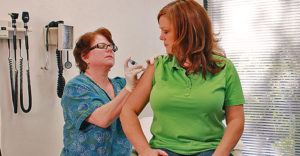
During those hot summer months, it is important to keep an eye on your skin. Many people will get a sunburn if they stay out in the sun too long with no protection. One of the most common ways to prevent burns is to use sunscreen. But with so many options in our pharmacies or grocery stores, why use it and how do you know what the right option is?
We asked Dr. Jessica J. Krant, an Assistant Clinical Professor of Dermatology at SUNY Downstate Medical Center who also works at Laser & Skin Surgery Center of New York City, how sunscreen works and the importance of specific SPFs.
 Name: Jessica Krant
Name: Jessica Krant
Occupation: Assistant Clinical Professor of Dermatology
Campus: SUNY Downstate Medical Center
Question: How does sunscreen work and what do the differences in SPF mean?
Here is what she said:
“Basically, sunscreen works by reducing damage to our skin from the sun’s otherwise harmful UVA and UVB radiation. Ingredients that work as sunscreens work in two basic ways: via physical or chemical methods. Physical sunscreens (zinc oxide and titanium dioxide) truly only work by sitting on the skin and directly reflecting the sun’s rays. Chemical sunscreen ingredients get absorbed into the skin’s cells and stabilize them so they are less reactive to sun. Both have pros and cons, and both have slightly different ranges of UV wavelengths that they block best.
Physical blockers don’t rub in as well, and are more easily washed off in water and with sweating and rubbing (because they are on the surface). Chemical blockers are more stable and are more cosmetically elegant, but have given rise in certain circles to some concerns about safety. There are efforts to address drawbacks of both categories, but the takeaway message is that the American Academy of Dermatology feels that no sunscreen ingredients have ever been proven to harm people via rigorous scientific testing in real world situations, while skin cancer caused by sun exposure is known to maim and even kill.”
But what about SPF numbers? Are higher SPF numbers really important?
“There is a bit of a myth on the internet that no SPF higher than 30 makes any difference at all. The reality is that this is a more complex question. SPF (Sun Protection Factor) actually refers only to the protection from UVB rays. In the United States, there is still no rating system similar to Europe’s star system that rates the quality of UVA protection. This matters because both UVA and UVB rays can cause aging and cancer, despite what we are told by marketers.
When selecting a sunscreen, first make sure it is labeled “Broad Spectrum”, which is America’s way of signaling adequate UVA protection. Next, check the UVB rating. SPF 15 is enough for daily use in a sunscreen moisturizer for a regular daily urban user who wants protection on the way to and from work. But SPF 30 is a better baseline for everyday, and is the minimum protection that should be used on a beach day. Though the differences in protection between SPF 30, 50, and 70 get smaller as the numbers increase, there is indeed still technically more protection.
One of the reasons to choose a higher number SPF is that these numbers are tested in a lab using an enormous amount of sunscreen (a full ounce for exposed skin, plus full reapplication every two hours), and that real humans usually are not so diligent. Putting too thin a layer on will mean you aren’t getting the level of protection advertised. “Cheating up” in SPF helps mitigate that a bit, but the rule about reapplication more often with sweating and swimming still applies. Don’t forget sunglasses, protective clothing, protective sun hats, and avoiding mid day hours and you’ll be all set!”
So don’t forget to apply that protective layer to keep your skin healthy and bright.
Professor Krant has much more knowledge on the subject. She is a board-certified dermatologic surgeon with 13 years of experience providing medical and cosmetic dermatological treatments and procedures. For more information, visit the website for the Art of Dermatology, her clinical practice in New York City.



